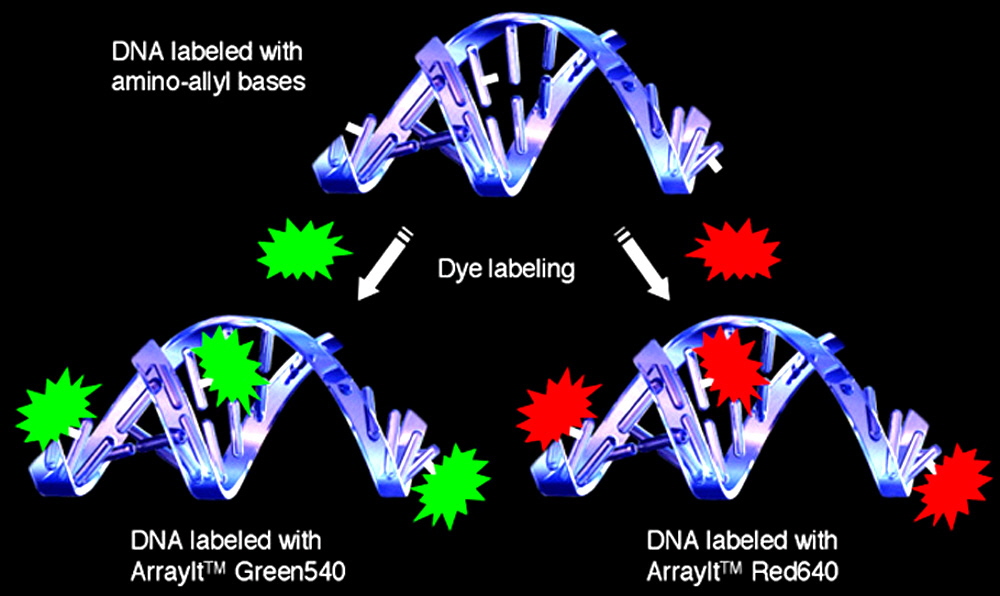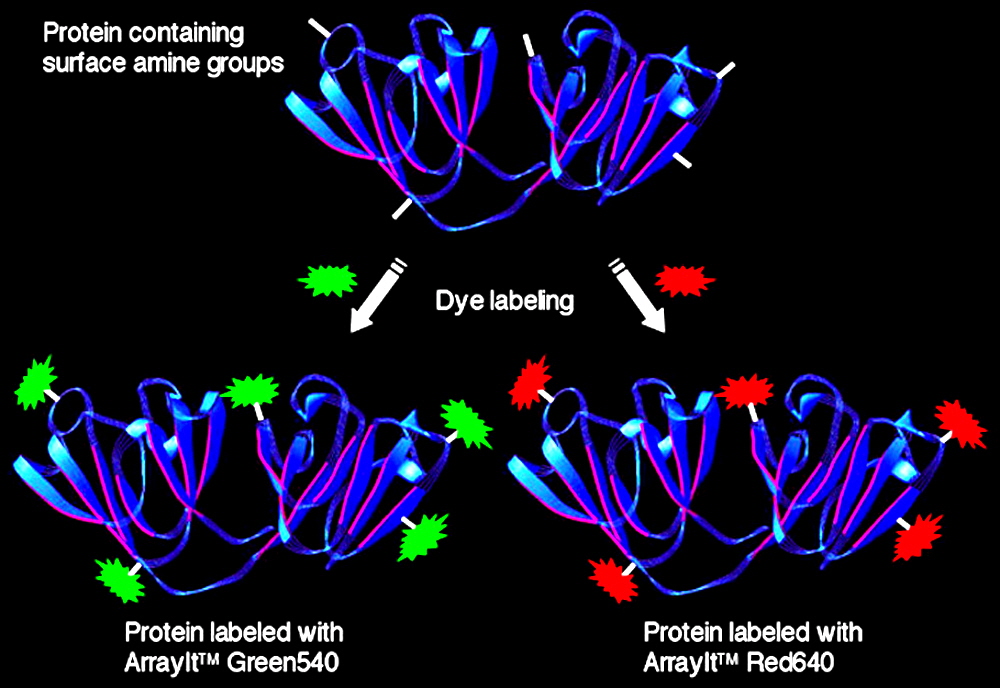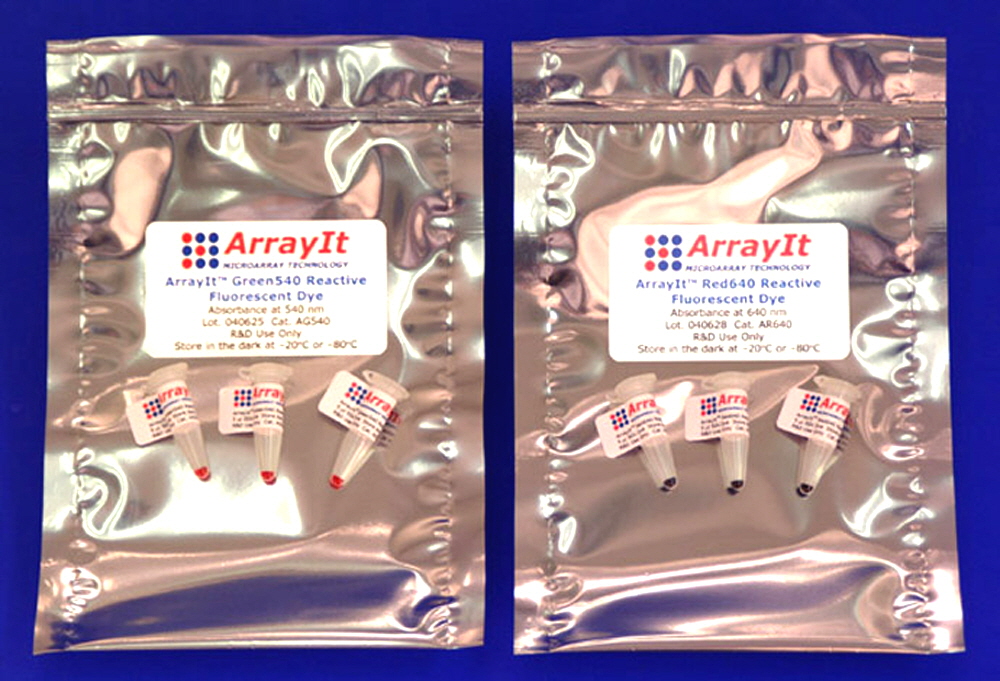Arrayit Red and Green Dyes
Data Sheet
![]() Shop this product in our online store
Shop this product in our online store
Arrayit | AG540 AR640 reactive green red cyanine 3 cyanine 5 540 nm 640 nm DNA protein microarrays life sciences research
Reagents - Microarray Labeling - Arrayit Green 540 nm and Red 640 nm Monoreactive Microarray Dyes for Indirect Aminoallyl DNA and Direct Protein Labeling

Arrayit announces a new generation of amine-reactive fluorescent dyes for a wide range of DNA and protein microarray applications. Arrayit Green540 and ArrayIt Red640 Reactive Fluorescent Dyes set a new standard for purity, labeling efficiency, chemical and photo-stability, ozone-resistance, usability, and affordability. ArrayIt dyes arrive pre-mixed as highly concentrated 10X solutions and are ready to use. Our proprietary buffer system stabilizes Arrayit Green540 and Arrayit Red640 to provide the brightest fluorescent probes available. Arrayit Green540 and Arrayit Red640 absorb and emit at the Cy3 and Cy5 wavelengths and are compatible with all major brands of fluorescent scanners and imagers.
Table of Contents
- Introduction
- Quality Control
- Product Description
- Table 1
- Table 2
- Short Protocol
- Technical Notes
- Recommended Products
- Troubleshooting Tips
- Technical Assistance
- Storage Conditions
- Ordering Information
- Warranty
Introduction
Congratulations on taking an important step towards improving the affordability, quality and speed of your genomics, biomedical, pharmaceutical and agricultural research. This booklet contains all the information required to take full advantage of Arrayit Green540 and Arrayit Red640 Reactive Fluorescent Dyes.
Quality Control
Arrayit takes every measure to assure the quality of our Arrayit Green540 and Arrayit Red640 Fluorescent Dyes. Each dye lot is suspended to a precise 10X concentration in our proprietary buffer system to ensure consistent concentration and stability specifications. All key manipulations including re-suspension, liquid transfer, packaging, and testing are performed in ribonuclease-free class 1 cleanrooms for superior dye quality. Rigorous quality control and quality assurance procedures guarantee that Arrayit Green540 and Arrayit Red640 Fluorescent Dyes exceed the highest industry standards.
Product Description
Arrayit Green540 and Arrayit Red640 Reactive Fluorescent Dyes represent the world’s most advanced amine-reactive dye set for a wide range of DNA and protein microarray labeling and detection applications. The dyes are ideal for oligonucleotide, cDNA, antibody, peptide, and other types of microarrays.
Users will appreciate the following features of the latest Arrayit innovation:
- Absorb and emit at the Cy3 and Cy5 wavelengths
- Much more stable than Cy3 and Cy5
- Matching structures provide equivalent labeling efficiencies for the two dyes
- Less than 1 part per billion (10-9) contamination of one dye in the other
- Ideal for one and two color applications
- React with any amino or amino-allyl containing molecule
- Compatible with many different labeling buffers
- Label amino-allyl DNA, native and recombinant proteins, and antibodies
- Highly resistant to chemical and light degradation
- Resistant to atmospheric ozone
- Buffering system stabilizes dyes during storage and use
- Compatible with all major brands of microarray scanners
- Suited for a wide range of genomics and proteomics applications
- Compatible with glass- and membrane-coated microarray substrates and slides
- High quantum yield for efficient detection
- Improve assay sensitivity and detectivity
- Stable for 12 months (-80°C)
- Compatible with the entire ArrayIt product line
- Shipped on dry ice, pre-mixed and ready to use
- Works great with Arrayit Brand Purification Kits
Table 1. Optical Properties of Arrayit Green540 and Arrayit Red640.
Parameter |
Description |
ArrayIt Green540 |
ArrayIt Red640 |
Stock concentration |
Concentration of the packaged dye |
10X |
10X |
Excitation laser color |
Color of laser light used to excite the dye for fluorescence detection |
Green |
Red |
Absorption maximum |
Wavelength corresponding to the strongest absorption of light |
540 nm |
640 nm |
Emission maximum |
Wavelength corresponding to the strongest emission of light |
568 nm |
668 nm |
Molar extinction coefficient |
Molar absorptivity of the dye attached to a molecule |
120,000 M-1 cm-1 |
203,000 M-1 cm-1 |
Technical Notes
Arrayit Green540 and Arrayit Red640 are a structurally matched set of fluorescent dyes that react with molecules containing free primary amine groups such as amino-allyl modified DNA, native proteins, recombinant proteins, monoclonal and polyclonal antibodies, and other molecules of interest in microarray analysis. Aminoallyl groups are added to DNA and RNA by incorporation of modified nucleotides containing aminoallyl groups attached to the DNA or RNA base. Proteins and peptides label naturally by virtue of containing primary amines on the surfaces as side chains of lysine and arginine residues. The dyes react in a stoichiometric manner with amino groups such that a single Arrayit Green540 or Arrayit Red640 molecule couples to a single amino group. The dyes absorb and emit at wavelengths that closely match Cy3 and Cy5, and are good replacements for users seeking dyes with greater stability and brightness.
The dyes derive their names from the color of laser light used for excitation. Arrayit Green540 uses green laser light (532 or 543 nm) for excitation, and Arrayit Red640 uses red laser light (633 or 635 nm) for excitation. The dyes themselves appear as red and blue colored solutions, respectively, and their physical appearance should not be confused with the naming system.
Arrayit Green540 and Arrayit Red640 are provided as highly concentrated 50X solutions instead as dry powders. This has several important advantages. Our proprietary buffer that contains stabilizing agents that extend the longevity of the dyes. Using a single, highly controlled buffer, rather than different reagents in each end-user laboratory, increases performance uniformity and allows all users to compare data on a one-to-one basis. Liquid dyes do not require re-suspension and are much easier and convenient to use.
Arrayit Green540 and Arrayit Red640 Fluorescent Dyes are shipped on dry ice and should be transferred to –20°C or –80°C immediately upon receipt. The dyes should be stored frozen and in the dark at all times, and in the silver packing envelope supplied with the product to prevent condensation from forming on the outside of the tube. Dyes stored in this manner are stable for 3 months (–20°C) or 6 months (–80°C) from the date of receipt. Each package contains 30 µl of 10X dye in a micro-centrifuge tube. The tube of dye should be thawed immediately prior to use, leaving the remaining tubes frozen until they are needed. For small experiments requiring partial aliquots, the dye should be thawed quickly and re-frozen immediately after the aliquot is withdrawn. Rapid re-freezing can be achieved by submersing the tube into liquid nitrogen or into an ethanol bath containing dry ice, making sure the dye droplet solidifies prior to returning it to –20°C or –80°C. Repeated freeze-thaw cycles, and exposure to moisture and light reduce dye stability and should be avoided.
Arrayit dyes react in a highly efficient manner with primary amine groups. The number of dyes that couple to the probe molecules of interest depend on the number of amines on the molecule and on the labeling conditions. A typical cDNA molecule labeled with aminoallyl-modified nucleotides contains a reactive aminoallyl group every 10-20 bases or approximately 50-100 reactive groups per 1,000 nucleotide (1 kb) molecule, producing a highly fluorescent cDNA containing 50-100 Arrayit Green540 or Arrayit Red640 labels. Most proteins label to a specific activity corresponding to 5-10 labels per protein molecule, and are brightly fluorescent while retaining binding and enzymatic activity. The number of fluors per molecule can be increased or decreased by changing the dye concentration, the reaction time, and the reaction temperature. Increasing the dye concentration, reaction time and reaction temperature increase labeling efficiency, and reducing dye concentration, reaction time and reaction temperature reduce labeling efficiency. These factors can be controlled to prepare probe mixtures that are more or less brightly fluorescent, depending on the application. Generally, more brightly fluorescent probes produce the strongest microarray signals and are desirable unless the dye labeling becomes excessive to the point where the binding reaction is inhibited by the presence of too many dye molecules on the surface. Titration experiments using a 10- to 50-fold range of dye concentrations can be used to select the optimal labeling concentration for Arrayit Green540 and Arrayit Red640.

Figure 1. Arrayit Green540 and Arrayit Red640 Fluorescent Dye labeling of DNA is shown schematically. DNA (blue ribbons) is labeled by incorporating aminoallyl-modified nucleotides (white bars) into the DNA strand. Arrayit Green540 (green icons) and Arrayit Red640 (red icons) react covalently with the primary amines of the aminoallyl groups, producing brightly fluorescent DNA that absorbs and emits light at the same wavelengths as Cy3 and Cy5. Arrayit Green540 and Arrayit Red640 can be used for a wide spectrum of DNA labeling applications.

Figure 2. Arrayit Green540 and Arrayit Red640 Fluorescent Dye labeling of proteins is illustrated schematically. A three-dimensional protein molecule (blue ribbons) contains primary amine groups (white bars) on the protein surface as side chains of the amino acids lysine and arginine. Arrayit Green540 (green icons) and Arrayit Red640 (red icons) react covalently with the primary amines of lysine and arginine, producing brightly fluorescent proteins that absorbs and emits light at the same wavelengths as Cy3 and Cy5. Arrayit Green540 and Arrayit Red640 can be used to label a wide spectrum of protein molecules including native proteins and protein extracts, recombinant proteins, protein domains, monoclonal and polyclonal antibodies, and peptides.
Table 2. Arrayit Green540 and Arrayit Red640 Labeling Reactions.
Application |
Starting Sample (µg) |
Description of Reactions |
Volume of 50X Dye (µl) |
Messenger RNA (mRNA), complementary DNA (cDNA) or genomic DNA labeled by incorporation aminoallyl-modified nucleotides |
2.5-5 µg nucleic acid |
Messenger RNA (mRNA), cDNA or DNA is primed using random primers or oligo-dT and extended in the presence of amino-allyl dNTPs to produce nucleic acids bearing amino-allyl groups every 10-20 nucleotides. Arrayit Green540 and Arrayit Red640 dye molecules couple covalently to amino-allyl groups at a 1:1 stoichiometry. |
10 µl |
Aminoallyl labeled cDNA derived from total cellular RNA |
50-100 µg total cellular RNA |
Messenger RNA (mRNA) is primed with oligo-dT and extended in the presence of amino-allyl dNTPs to produce cDNA bearing amino-allyl groups every 10-20 nucleotides. Arrayit Green540 and Arrayit Red640dye molecules couple covalently to amino-allyl groups at a 1:1 stoichiometry. |
10 µl |
Synthetic 40-mer peptide |
2 µg synthetic peptide |
A purified synthetic peptide with a molecular weight of 5,400 grams/mole is labeled by coupling dye molecules to N-terminus of the peptide. Arrayit Green540 and Arrayit Red640 couple covalently to reactive amino-terminal groups at a 1:1 stoichiometry. |
10 µl |
Purified recombinant protein or antigen |
50-100 µg purified protein |
A purified recombinant protein or antigen with a molecular weight of 30-100 Kd is labeled by coupling dye molecules to lysine (Lys) and arginine (Arg) residues on the protein surface. Arrayit Green540 and Arrayit Red640 couple covalently to reactive amine groups at a 1:1 stoichiometry. |
10 µl |
Purified monoclonal or polyclonal antibody |
50-100 µg antibody |
Purified monoclonal or polyclonal antibodies with an average molecular weight of 140 Kd are labeled by coupling dye molecules to lysine (Lys) and arginine (Arg) residues on the antibody surface. Arrayit Green540 and Arrayit Red640 couple covalently to reactive amine groups at a 1:1 stoichiometry. |
10 µl |
Total cellular protein |
50-100 µg total cellular protein |
Total cellular protein lysates with an average protein molecular weight of 50-100 Kd are labeled by coupling dye molecules to lysine (Lys) and arginine (Arg) residues located the protein surface. Arrayit Green540 and Arrayit Red640 couple covalently to reactive amine groups at a 1:1 stoichiometry. |
10 µl |
Short Protocols
1. Prepare a sample of aminoallyl DNA, proteins, peptides or other molecules.
2. Purify the sample to remove contaminants (e.g. Tris).
3. Label with Arrayit Green540 or Arrayit Red640 for 1-2 hours.
4. Purify the labeled probe molecules from the unincorporated dye.
5. Hybridize or bind the fluorescent sample to a microarray.
6. Wash and scan the fluorescent microarray.
7. Analyze and model the data.
Important!: Not compatible with Invitrogen SNAP cleanup columns. Use Arrayit Fluorescent Probe Purification Kit, Catalog ID, FPP for best results.

Figure 3. Arrayit Green540 or Arrayit Red640 dyes were diluted from 10X stock solutions into distilled water and printed onto SuperAmine Substrates using a SpotBot® Personal Microarrayer with a SpotBot® 2 Upgrade and 946MP4 Pins and a 946PH Printhead. The 946MP4 Pins (0.004”) produced 150 µm spots and center-to-center spacing was 200 µm. Scanning was performed using a ScanArray Express (PerkinElmer) set at 90% laser power and 50% PMT. The Arrayit Green540 (“Cy3”) and Arrayit Red640 (“Cy5”) channels were combined into a single composite image for viewing simplicity. The data reveal strongly intense fluorescence of the Arrayit Green540 or Arrayit Red640 dyes, with no detectable channel-to-channel crosstalk. Additional experiments (not shown) confirm that the two dyes have <10-9 (less than 1 part per billion) contamination of the other dye, indicating the high purity of Arrayit Green540 or Arrayit Red640 dyes. The dyes are ideal for both one- and two-color experimentation. The scale bar (white) corresponds to 250 µm.
Recommended Products
Our Arrayit Green540 or Arrayit Red640 Reactive Fluorescent Dyes are best used in conjunction with our complementary ArrayIt product line. Here are some recommended products that work well with Arrayit Green540 or Arrayit Red640:

Figure 4. Arrayit Green540 (left) or Arrayit Red640 (right) Reactive Fluorescent Dyes are provided as concentrated 10X solutions and are shipped on dry ice. Each package contains a total of 30 µl of 10X dye. Antistatic packaging prevents static electrical transfer to the dye molecules and improves storage stability. Arrayit Green540 or Arrayit Red640 should be stored frozen in the antistatic envelope and in the dark at –20°C or –80°C, and should be thawed immediately prior to use.

Figure 5. Arrayit Green540 or Arrayit Red640 Reactive Fluorescent Dye absorption spectra. Equimolar dye concentrations (1 µl) were scanned from 300-700 nm using a NanoDrop® Spectrophotometer. The absorption spectra reveal absorption maxima of 540 nm and 640 nm, respectively, for Arrayit Green540 (left) or Arrayit Red640 (right).
Troubleshooting Tips
Poor labeling efficiency of sample molecules
- Amine-containing components in buffer (e.g. Tris). Make sure to use a buffer (e.g. carbonate, PBS) that is free of amino groups.
- Insufficient dye used for labeling. Check the sample concentration and consult Table 2 for the proper dye amount.
- Dye has lost chemical reactivity due to poor storage. Make certain to store dyes in the dark at –20°C or –80°C.
Poor binding efficiency to the microarray
- Too many fluorescent groups per molecule. Reduce dye concentration until binding efficiency improves.
Technical Assistance
Please contact us if you have any comments, suggestions, or if you need technical assistance. By electronic mail: arrayit@arrayit.com(under the subject heading please type "ArrayIttechnical assistance"). By email: arrayit@arrayit.com, Monday–Friday PST 9:00am - 4:30pm. Please remember that we want to hear about your successes!
Storage Conditions
Arrayit Green540 and Arrayit Red640 Reactive Fluorescent Dyes are stable for 6 months from the date of purchase when stored in the dark at –20°C, and 12 months from the date of purchase when stored in the dark at –80°C. Avoid exposure to humidity and light at all times. Thaw the frozen dye solutions immediately prior to use, remove the amount of 50X dye required, re-freeze the remaining solution, and store at –20°C or –80°C. Dyes should be re-frozen using liquid nitrogen or an ethanol bath containing dry ice to ensure rapid re-freezing. Dyes should always be stored in the silver anti-static package to prevent static electrical transfer to the solutions and prevent exposure to moisture. When opening the micro-centrifuge dye tubes, always wear gloves and refrain from touching the underside of the tube top to prevent contamination by hand oils and ribonucleases.

